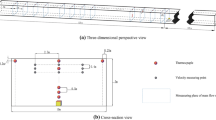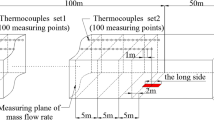Abstract
This paper presents a mathematical model to predict the instantaneous temperature profiles in sealed or ceiling vented compartment fires. It has been observed in the existing research that in compartments without vertical opening, smoke fills the volume very soon indicating that the so-called one-zone type distribution forms quickly, and the gas temperature inclines linearly with height above the fire source. These characteristics are different from the smoke filling properties in enclosure fires with vertical openings. An assumption of linear distribution for temperature was introduced and a modified one-zone model was subsequently proposed in order to predict the transient smoke temperature profiles after the smoke fills the enclosure. With the knowledge of the heat release rate, the prediction model was established based on unsteady energy conservation by changing the heat loss factor using the semi-empirical models for fire plume and ceiling jet. Experiments including sealed and ceiling vented conditions were conducted to validate the model and the comparisons between measurements and predictions suggested the model can give fairly satisfactory estimations for the transient temperature profiles for both tests.








Similar content being viewed by others
References
Karlsson B, Quintiere JG (2000) Enclosure fire dynamics. CRC Press, Boca Raton
James GQ (2002) Fire behavior in building compartments. Proc Combust Inst 29(1):181–193. doi:10.1016/s1540-7489(02)80027-x
Tan Q, Jaluria Y (2001) Mass flow through a horizontal vent in an enclosure due to pressure and density differences. Int J Heat Mass Transf 44(8):1543–1553. doi:10.1016/s0017-9310(00)00198-8
Stern-Gottfried J, Rein G, Bisby LA, Torero JL (2010) Experimental review of the homogeneous temperature assumption in post-flashover compartment fires. Fire Saf J 45(4):249–261. doi:10.1016/j.firesaf.2010.03.007
Walton WD, Thomas PH (2002) Estimating temperatures in compartment fires. In: DiNenno PJ, Walton WD (eds) SFPE handbook of fire protection engineering, vol 3, 3rd edn. National Fire Protection Association, Bethesda, pp 171–188
Zukoski EE (1978) Development of a stratified ceiling layer in the early stages of a closed-room fire. Fire Mater 2(2):54–62
Mowrer FW (1999) Enclosure smoke filling revisited. Fire Saf J 33(2):93–114. doi:10.1016/s0379-7112(99)00023-5
Delichatsios M (2003) Closed form approximate solutions for smoke filling in enclosures including the volume expansion term. Fire Saf J 38(2):97–101. doi:10.1016/s0379-7112(02)00052-8
Beyler CL (1991) Analysis of compartment fires with overhead forced ventilation. Paper presented at the proceedings of the third international symposium on fire safety science, Scotland, UK, 8–12 July
Mulholland G, Handa T, Sugawa O, Yamamoto H (1981) Smoke filling in an enclosure. Fire Sci Technol 1(1):1–31
Chow WK, Zou GW (2009) Numerical simulation of pressure changes in closed chamber fires. Build Environ 44(6):1261–1275. doi:10.1016/j.buildenv.2008.09.016
Li CH (2010) Experimental study on pool fire behaviors in closed compartment on ship. Dissertation, University of Science and Technology of China, Hefei, China
Chen B (2011) Experimental study on pool fire environment in ship room with ceiling vent. Dissertation, University of Science and Technology of China, Hefei, China
Peatross MJ, Beyler CL (1994) Ventilation effects on compartment fire characterization. Paper presented at the proceedings of the fourth international symposium on fire safety science
Sugawa O, Kawagoe K, Oka Y, Ogahara I (1989) Burning behavior in a poorly-ventilated compartment fire-ghosting fire. Fire Sci Technol 9(2):5–14
Cooper LY (2002) Compartment fire-generated environment and smoke filling. In: DiNenno PJ, Walton WD (eds) SFPE handbook of fire protection engineering. Hazard calculations, vol 3, 3rd edn. National Fire Protection Association, Bethesda, pp 243–267
Mowrer FW (1992) Methods of quantitative fire hazard analysis. Electric Power Research Institute, Palo Alto
Hamins A, Johnsson E, Donnelly M, Maranghides A (2008) Energy balance in a large compartment fire. Fire Saf J 43(3):180–188. doi:10.1016/j.firesaf.2007.08.002
Audouin L, Bourniaire B (1999) New estimation of the thermal interface height in forced-ventilation enclosure fires. Paper presented at the proceedings of the sixth international symposium on fire safety science, Poitiers, France, July 5–9
Heskestad G (1984) Engineering relations for fire plumes. Fire Saf J 7(1):25–32. doi:10.1016/0379-7112(84)90005-5
Heskestad G, Hamada T (1993) Ceiling jets of strong fire plumes. Fire Saf J 21(1):69–82. doi:10.1016/0379-7112(93)90005-b
Quintiere JG, Grove BS (1998) A unified analysis for fire plumes. Symp Int Combust 27(2):2757–2766. doi:10.1016/s0082-0784(98)80132-x
Chen B, Lu SX, Li CH, Kang QS, Lecoustre V (2011) Initial fuel temperature effects on burning rate of pool fire. J Hazard Mater 188(1–3):369–374. doi:10.1016/j.jhazmat.2011.01.122
Santo G, Delichatsios MA (1984) Effects of vitiated air on radiation and completeness of combustion in propane pool fires. Fire Saf J 7(2):159–164. doi:10.1016/0379-7112(84)90036-5
Acknowledgements
This work was sponsored by National Natural Science Foundation of China with Projects No. 50976109.
Author information
Authors and Affiliations
Corresponding author
Rights and permissions
About this article
Cite this article
Yuan, M., Lu, S., Zhou, Y. et al. A Simplified Mathematical Model for Predicting the Vertical Temperature Profiles in Enclosure Fires Without Vertical Opening. Fire Technol 50, 929–943 (2014). https://doi.org/10.1007/s10694-012-0315-4
Received:
Accepted:
Published:
Issue Date:
DOI: https://doi.org/10.1007/s10694-012-0315-4




